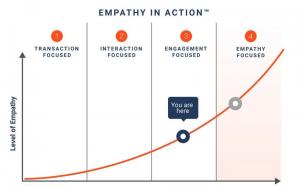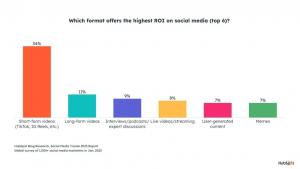
Content creation is all the rage in digital marketing these days. Everyone wants to create content that grabs eyeballs, like a Starbucks joint or a sale at Target. There are listicles upon listicles on the internet where gurus just stop short of betting their lives to convince people that they have the magic potion to create the most earth-shattering content, but here’s a thing. While content creation gets a lot of attention, very few people give the importance to content engagement that it deserves.
See, content creation is a paramount skill to have. After all, today, we are consuming content like people were consuming hamburgers in the 20th century. With this profusion of content on each platform, who gets to decide which content is the best? The answer: the audience. No content is viral when it is created. It goes viral when people engage with it — like it, tag their friends, and share in groups. In short, numbers on three icons; the thumb, the message bubble, and the arrow decide which content will be called “viral”. And convincing people to keep pressing these icons is a skill.
You don’t have to take a masterclass for that. We have condensed our entire knowledge of content engagement strategies into these 6 effective tips.
1. Leverage your personal profile for content engagement
Every platform has personal profiles and business pages. They are like jelly and peanut butter. They are great individually, but they work even better when combined. Using personal accounts to promote your business content is a wise strategy to draw engagement on your content. There is one simple reason for it.
Our personal profiles feature friends, family, and colleagues. They love us and want to see us grow (not all of them maybe). But the point is, sharing your content with them could create natural engagement. They’ll watch it. Of course, some might do it just out of courtesy, but whatever takes that views count up works for us. If they like it, they’ll share it with friends and family, and before you know it, a chain has already been created.
It is an efficient technique to bring your content in front of like-minded people. It also gives a human face to businesses that are otherwise just logos, and products. In today’s day and age, people running a business are as important as the business itself. Take the example of Neil Patel. The guy runs a business, but it is his face that sells. Would you rather watch a Neil Patel video or read a blog on his website? It’s the first one. His face has become the brand, and that’s what drives the engagement.
In the words of Neil: “Your customers want to feel connected to you, and that connection helps build trust.”
2. Foster two-way communication
Another way to really turbocharge your engagement is communication. It takes you places. Your words can propel you to new heights or throw you from there. So, use them wisely.
In the capitalist world, brands have become faceless. They want to sell products, but they want to do it from behind a wall. They don’t even want to communicate. They have AI chatbots for that purpose. When was the last time a brand or a company went viral because their AI chatbot responded to a consumer? It didn’t happen.
People want brands to respond to their needs. According to a study by the global customer experience leader Genesys, 83% of people want customer service employees to listen to them and understand their needs.

There’s no need to plan elaborate audience engagement strategies. There are simpler ways to do it. For example, a consumer mentions an issue with your product or service on social media. Take some time out to reply and address their concerns promptly. Now you have a happy customer. Here’s what you can do: send them a gift voucher by email for the trouble they went through or ask them to participate in a free giveaway contest. Who doesn’t love freebies? Bring them to your website and socials.
A study showed that when a person tweets at a business and receives a response, they are willing to spend about 20% more to buy items from that business.

We all remember Coca-Cola’s ‘Share a Coke’ campaign. It encouraged people to share their customized Coke bottles on social media. Within the first year of the campaign, consumers shared more than 500,000 photos via the ‘#ShareaCoke’ hashtag, with the brand gaining roughly 25 million new Facebook followers.
1. Make the audience part of the process
Brands and companies are only as good as the products they sell or services they offer. Product development is a nuanced process, but it also can be one of the most potent marketing engagement strategies.
See products must align with the needs and expectations of the customers. So why not make them a part of the process? Whenever a brand plans to launch a new product or service, it should ask the audience what they want from it. Take a survey and allow the audience to give input. Post questions on social media and let people share thoughts.
This has two benefits. One, you are getting more engagement on your social media, and second, your product is a guaranteed success because it is just what people wanted. This also makes the audience feel a part of the process. The feeling that the brand values its customers is priceless.
2. Create a content mix
It is a no-brainer in today’s world to have a strong presence on each social media platform. But managing different accounts means you need to post content that’s relevant to the platform. Some favor media and graphical content more than text, while others promote videos. Having your content tailor-made for each platform is a strategy to maximize content engagement.
This is not something that you should “also” do. This is something you must do. Why? because 51% of consumers unfollow brands on social media because they post irrelevant content.
Having a mix doesn’t only mean you should have assorted forms of content. Your content should be curated for the platform to the last pixel. For example, the ideal dimension for a Facebook image is 1200 x 628 pixels, and for Instagram, it’s 1080 x 1350 pixels. Using the same image for both platforms would leave a black space on the sides. As a content consumer, you’d agree that it looks a bit pesky.
The same goes for videos. Posting Reels as YouTube videos is not a good look at all. Not only do they look unappealing, but their average watch time is also considerably low.
3. Focus on vertical content and short video format
Of all the engagement tips I mentioned in this blog, this one is my favorite: Produce vertical videos.
Vertical videos are turning people into superstars these days. With TikTok, YouTube Shorts, Instagram Reels, and Snapchat, gone are the days when smartphones were tilted to record videos. This type of content is easy to create and fun to consume. And people love it.
It’s no surprise that marketers have understood this. Short-form video is the top trend marketers will be leveraging in 2023, and HubSpot’s Social Media Trends Report (2023) found that it is the highest ROI format for social media marketing.

Now that so many platforms are desperate to become ‘the new TikTok’, you can bet they push vertical content to reach more and more audience. According to one research, 90% of vertical videos have a higher watch completion rate compared to horizontal ones. And creators can reach 58% more people with vertical videos. In terms of engagement, vertical videos generate four times more engagement on Facebook and 2.5 times more on Twitter.
1. Bump old posts
Of all the tips in this blog, this one is, hands down, the most cost-effective. Actually, it’s a zero-cost strategy.
See, every post has a shelf-life, after that, it disappears from your followers’ feeds. I mean according to Zippia, at least 95 million photos and videos are posted on Instagram each day. How long do you think your post will remain visible?
So, bumping up old posts is a good way to get more engagement without producing any new content. For this, you can use the scattered response technique. Say you have posted new content. People liked it. Some have also commented on it. These comments can be appreciation or questions. Yes, I know there’s this urge to immediately reply with, ‘Oh Thanks. I’m glad you liked it’, but don’t do it.
Let the comment sit for some hours or a day. After a few hours, your post’s shelf life has started to end. It is your job to bump it up again. Now reply to those comments. Those who commented will get a notification, and they will certainly have something to ask or say in response.
Here’s an added benefit: the followers of those who commented will also see the post on their feeds as it happens on Twitter. Who knows, they might also have something to say about your post. And just like that, we didn’t do anything, and yet we are sitting back and seeing the like, comment, and share count go up.
Parting Thoughts
Content engagement is equally important as content creation. We all want ‘your friend and 100 others liked it’ under our posts. Your content is only as good as the number of people who engage with it. As long as it keeps happening, we find the motivation to produce more. Whether you are running a personal account or a brand, these are some strategies that will make sure you are rewarded as much as the effort you put into creating the content. So go ahead, make your customers happy, and be ready to win the marketing and sales game.